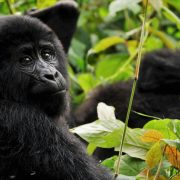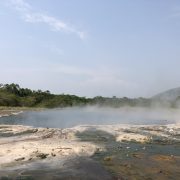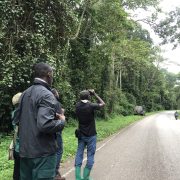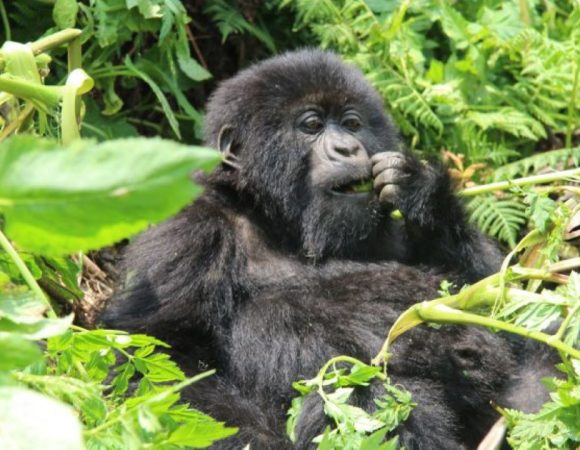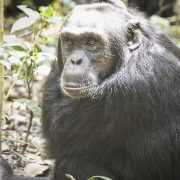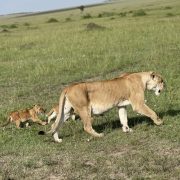
Aberdare National Park : Things to do in Aberdare National Park
Protecting the Aberdare Mountain Ranges, Aberdare National Park is one of Kenya’s popular national parks as it is home to the Big Five wildlife. Aberdare National Park is a 766 square kilometers protected area that offers a visitor incredible wildlife sightings while on safari in Kenya. The national park is located 100 km north of Nairobi which is Kenya’s capital city and is situated east of the East African Rift Valley.
Aberdare National Park is rich in bio diversity and an important water source for Kenya as four of the country’s seven largest rivers originate from the park. The Aberdares are a water catchment for the Tana River System, Lake Naivasha and the northern Ewaso Nyiro River. The rich bio diversity makes it a perfect destination for wildlife sightings, birding and other safari activities in the park.
Wildlife in Aberdare National Park
Aberdare National Park is home to the Big Five which include Lion, Leopard, Elephant, Buffalo and Rhino. The park is known for its large population of Black Rhinos and is the second best place to see black rhinos in Kenya. Other wildlife species to look out for while in Aberdare National Park include Bush bucks, East African Wild dog, Waterbucks, Mountain reedbuck, Giant Forest hog, Side-striped Jackal, Duikers, Olive baboons, Black-and-white colobus monkeys, Eland, Sykes Monkey, Suni, Serval, African golden cat (a rare sighting), Bongo, Warthogs and Large-spotted genet. Wildlife encounters in Aberdare National Park are best experienced while on a game drive in the park.

Birds in Aberdare National Park
The habitat types in Aberdare National Park harbor a variety of bird species and about 290 species of birds have been recorded at the park. This makes the national park a birding hot spot with chances of sighting montane specials, forest specials and mid to high elevation bird species. The most sought after bird in the park is the Aberdare Cisticola which is an endangered species and endemic to Kenya.
Other birds resident to the park include Jackson’s Spurfowl, Africa Cuckoo-hawk, Mountain Buzzard, Hartlaub’s Turaco, Scarlet-tufted Sunbird, Tacazze Sunbird, Olive Ibis, Ayre’s Hawk-eagle, Crowned Eagle, Striped flufftail, Cape Eagle-owl, African Fish eagle, Sparrow Hawk, African Goshawk, Abyssinian Crimsonwing, African Paradise Flycatcher, Cinnamon chested Bee-eater, African yellow Warbler, Bar-tailed Trogon, Doherty’s Bush-shrike, Golden-winged Sunbird, Jackson’s Francolin, Moorland Francolin, Montane White-eye, Hunter’s Cisticola, Moustached green Tinker bird, Sharpe’s Longclaw, White-headed Wood-hoopoe, Silvery-cheeked Hornbill, Tambourine dove among others. Birding in Aberdare national park can be done throughout year however the best time to bird is between November to April when the migrant species from North Africa and Europe are present at the park.
Vegetation of Aberdare National Park
The park is diverse with different vegetation types that are a part of the greater Aberdare National Park Eco system. The park has a large elevation range from 1,800 m – 4,001m above sea level and vegetation is spread out at different elevation levels. The vegetation of Aberdare National Park therefore includes woody forest and scrub land is found below 2,500m, dense bamboo forests found from 2,500m to 3,000m, Hagenia forest is found at elevations between 3,000 to 3,300m, moorland habitat that is made up of alpine grassland and heath-land is found at elevations lying above 3,300m. The vegetation provides a range of habitats for bird life and wildlife resident to the park.
Top Things to do while in Aberdare National Park
Full Day Game Drives
Full day game drives are the top activity in the park that offers going out into the park in search of wildlife including the Big Five. Buffaloes and elephants are commonly sighted while on the game drive and Aberdare is one of the best places in Kenya to see the black rhinos (seen at Solio Ranch and Rhino Sanctuary). Lion and leopard are present at the park but can be difficult to spot since they live in higher altitude areas. Other wildlife to look out for while on the game drive include antelopes, primates like olive baboons, warthogs, East African wild dog etc. Night game drives can also be arranged for a chance of spotting nocturnal species like the hyenas and the African golden cat. While in Aberdare National Park you can also have fulfilling wildlife viewing opportunities from the tree hotels that usually overlook water holes and salt licks where animals like to gather offering one great views from the top.
Bird watching in Aberdare National Park
For the expert or specialist birder the national park offers great sightings as it is home to over 290 species of birds including endemic species. The Aberdare Mountain ranges are also an Important Bird Area (IBA) and was designated as an IBA in 1999 because it supports and is a habitat for significant population of bird species. The park is a worthy destination to consider while on a birding safari in Kenya. Bird species to look out for include the Aberdare Cisticola, Jackson’s Spurfowl,Hartlaub’s Turaco, Scarlet-tufted Sunbird, Tacazze Sunbird, Olive Ibis, Ayre’s Hawk-eagle, Crowned Eagle, Striped flufftail among other species.
Kereita Waterfall and Cave Excursion
One of the activities to do while at the park is the trail to Kereita waterfall and cave. The trail takes you through the Aberdare ranges with great opportunities to spot some birds as you trek to the waterfall. The Kereita waterfall is stunning and while her you can have wonderful photography moments. After spending time at the waterfall you continue to the neighboring cave with your guide who will take you through the formation and history of the cave. Wildlife to look out for while on this trail include the black-and-white colobus monkey, elephants that are usually see by the elephant pool that is along the trail and sykes monkey.
Visit Kikuyu Village (Cultural Visit)
Visiting a Kikuyu village is one way to spend your time while on safari in Aberdare National Park. The Kikuyu people is a tribal group in Kenya that accounts for 17 % of the total population, the Kikuyu speak “Gikuyu” language as their native tongue as well as Swahili. The visit to the Kikuyu offers one a glimpse in to the culture, community and way of life of a Kenyan ethic group. You will also get acquainted with their customs, traditional wear and traditional dances.
HorseBack Riding
Horseback riding is a unique safari activity in Aberdare National Park that is available for visitors who would like to explore the open grasslands of the park on a horse. The ride brings one closer to wildlife in the park as the distance to some of the animals might be much closer than when in a car during the game drive. The guided horseback ride takes between 2-3 hours depending on your interest and a ranger guide is present at all times through the activity.
Nature Walks
A morning or afternoon in Aberdare National Park can be spent on a nature walk in the park. Nature walks start at the park headquarters with a briefing session that is headed by a trained park guide, after the briefing you begin the walk with your ranger guides. Nature walks involve experiencing the park on foot, following animal tracks, getting conversant with the vegetation of Aberdare as you look out for wildlife resident to the park.
Sun downers and Bush Meals
Aberdare National Park is also the perfect destination for bush meals amidst the national park. The national park offers perfect spots for bush breakfast, a private picnic or bush lunch all while enjoying expansive views of the Aberdare Mountain ranges and the stunning landscape of the park. Sun downers are also another great way to spend your time in Aberdare especially after full day game drives in the park, you get to end the day watching the sunset while sipping on your favorite drink.
Best time to visit Aberdare National Park
The national park is open to visitors throughout the year but of course it is much better to visit during the drier months. The dry months include the June to September months and January through February months. For visitors interested in bird watching in Aberdare National Park the best time to visit is between November to April as a lot of migratory species are available during this time, some will have already arrived and other species will be on their migratory journey.
Where to stay in Aberdare National Park
Aberdare National Park has a variety of accommodation facilities and a visitor to the park cannot fail to find a suitable accommodation option for their stay. Aberdare is known for its tree lodges that offer stunning game viewing opportunities from the top and we usually recommend that you book these as first priority for an opportunity to watch wildlife from an elevated view.
Lodges/Hotels in Aberdare National Park include:
The Ark Lodge: The Ark is the most popular lodge and is situated right in the heart of Aberdare National Park. The lodge has three decks with balconies and overlooks a water hole and salt lick which attracts wildlife from elephants to antelopes and buffaloes that like to come here to quench their thirst or wallow in the mud. The Ark is a perfect blend of luxury and unique wildlife encounters. The lodge has a well-stocked bar, dining area that serves different cuisine, a well-stocked library for visitors that love to read and well trained staff.
The Aberdare Country Club – situated on a slope of Mweiga hill in the Aberdare hihghlands, the county club is also an accommodation option to consider while on safari here. The area was formerly a homestead for an English couple that had settle in Kenya and was later turned into a country club that started welcoming guests. The site features a swimming pool, a lounge area, a restaurant serving delicious meals, a tennis court, a spa, gym, lush green gardens, a well-stocked bar and comfortable cosy rooms. This lodge is perfect for visitors looking for an all-inclusive experience.
Aberdare Cottages – This property is a budget accommodation facility just 8km away from Aberdare National Park overlooking a beautiful Mathioya River and the lodge offers walks to the river, a great way to spend an afternoon after the day’s activities in the park. The family run lodge has 15 chalets and these include wooden chalets, Eco chalets and tented chalets. Each chalet has a private balcony overlooking the river and a small lush forest. Each room is en-suite with hot showers available throughout the day.

